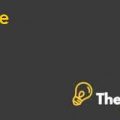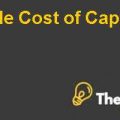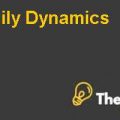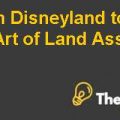Rosetta stone: Pricing the 2009 IPO Case Analysis
Introduction
This report is about Rosetta Stone. The company was founded by Allen Stoltzfus, in the year 1980. It is a language learning Software Company which is mostly committed towards establishing languages, brain fitness and education software. The company’s president and the CEO, Tom Adams, will make the company public by conducting its IPO. By using the valuation approaches, such as DCF method, the company share price and its equity value have been estimated. The estimated share price is at 47.7 per share. The company is currently facing some financial problems, so it’s looking for maximum financial advantages for the company with the increase in its capital structure. Hence, the company has gone for the IPO and attract shareholders to improve its brand name.(Papireddy, 2009)
Problem Statement
The company has been facing financial issues since the year 2008. The report has showcased the company’s decision-making process of going public with IPO during the time of world recession, which is considered as the most difficult era of raising capital. In this report, the company is also considering offering its initial share price at the most possible lowest price only to appeal a maximum number of shareholders. During the time of recession, it is very difficult for the investors to have trust in the company that has no prior records.
Situational Analysis
Common Size Income Statement (Question No. 1)
The common size income statement is also known as the vertical analysis that is done to analyze the financial statements of a company. In such a type of analysis, each item in the income statement is calculated as a ratio of company’s revenue and interpretations are done accordingly. The common size analysis of the organization’s income statement has been done in the report in which the accounts are represented as a percentage of sales revenue. From the calculations, it is analyzed that the company’s profit margins have been stable for about five years, whereas the operating margin of the company is not that good as it requires. The net profit margin of the company are also proved to be of poor state as it could be seen from the calculations that the company has been suffering losses for five years.
Note: Refer to the Exhibit 1 for calculations.
Cash Flow (CF) Statement (Question No. 2)
The calculations for the company’s CF statement have been done in this report for the year 2008. However, while determining the net value of the company, the company’s cash flows for further 10 years have been forecasted, assuming no revenues from the IPO. Positive cash flow of 47428 for the year 2008 is determined by the company. It implies that the company has been appended to the cash equivalents and has allowed for reinvesting in the future. It is evaluated that the company could maintain its cash position very well and can generate cash and can pay for its debts and do financing for its operating expenses conveniently. The positive figure of 28718 has been calculated as the amount of operating cash flows, whereas for investing activities it is determined to be of negative 2283, implying that investments have been done from the company for the purchase of assets. The figure for financing activities of the company has also been calculated as negative 1091.
Note: Refer to the Exhibit 2 for calculations.
The WACC (Question No. 3)
The weighted average cost of capital (WACC) is calculated as the company’s cost of capital for any of the category of capital, i.e. either for equity or for debt. From the calculations, the WACC of Rosetta has determined to b 3.52. WACC is used by the companies to estimate the fair and a practical price per share. For the estimations of beta, we have used the data co comparable companies’ unlevered beta and then converted that into the levered beta under the company’s debt/equity ratio. The WACC has supposed to be a great impact over the net enterprise value of the company. In order to examine that impact, we have done sensitivity analysis by bringing changes to the WACC and determine the changes in the company’s NPV and ultimately over the price per share.
Note: Refer to the Exhibit 3 for calculations.
The Discounted Cash Flows (DCF) Analysis (Question No. 4)
To determine the net value of the company before its IPO; the discounted cash flows (DCF)analysis is conducted. In the DCF analysis; the CFs of the company are estimated from 2009 to 2018, i.e. for upcoming 10 years assuming no revenue from the IPO or issuance of new shares. The CFs of the company are discounted back per each year using the discount rate of 0.071%. Higher discount rates provide lower NPV of the CFs, and vice versa. Furthermore, because of high discount rates, the CFs of the company discounted for the time is extensive, resulting the lower NPV. The CFs are forecasted for the upcoming 10 years by using the data given in the Exhibit 8 of the case. Because of the absence of data regarding the depreciation rates, which are essentially required for the calculations; the value is assumed by subtracting the ending balance of the PPE out of its opening balance, and then adding the capital expenditure for the year. The discounted terminal value (TV)is calculated to be 1179.0, whereas, the enterprise value (EV) is 779.93, the market value of equity is determined to be774.27, and the price per share by using the discounted cash flow (DCFs) is calculated to be 47.7.
Note: Refer to Exhibit 4 for calculations.
The Aftermarket Value (Question No. 5)
For the calculations of the company’s aftermarket net worth and its aftermarket price per share before issuing IPO, the EBITDA multiples of the comparable companies have been used. As per the calculations from the management the price per share is evaluated to be between 15 two 17 dollars as seen from the Exhibit 7. We have calculated the market value of the company by multiplying the company’s EBITDA for the year 2008 with the average EBITDA of comparable companies. The EV is determined to be 514. Then the market equity value was calculated to be 508 by subtracting the company’s total debt from is EV. Then this value was divided by the number of shares to get the price per share. The price per share of the company by using the EBITDA multiples of comparable companies is calculated to be 29.5. Whereas, using the DCF approach, it was calculated as 45.
Note: Refer to Exhibit 5 for calculations.
Sensitivity Analysis (Question No. 6)
For the sensitivity analysis, we have changed the average EBITDA of the comparable companies and figured out its impact over the price per share of the company using the EBITDA multiples approach. When average EBITDA is lower, i.e. 13.8, the price per share of the company tends to decrease, i.e. 27.5. When the EBITDA is higher, the price per share of the company tends to increase, i.e. 31.4.
Note: refer to Exhibit 6 for calculations....
Rosetta stone Pricing the 2009 IPO Case Analysis
order your own originally done case solution."}" data-sheets-userformat="{"2":14913,"3":{"1":0},"9":0,"12":0,"14":{"1":2,"2":3355443},"15":"Arial","16":10}">This is just a sample partial case solution. Please place the order on the website to order your own originally done case solution.













